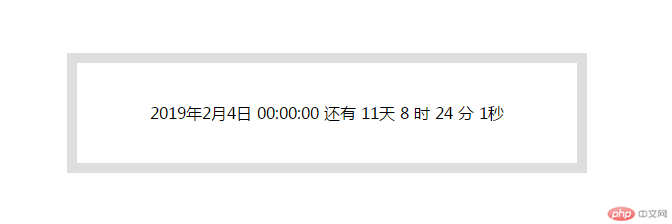Date对象创建语法:var myDate=new Date(); Date 对象会自动把当前日期和时间保存为其初始值
Date 对象方法:
Date() 方法可返回当天的日期和时间
getDate() 从 Date 对象返回一个月中的某一天 (1 ~ 31)。
getDay() 从 Date 对象返回一周中的某一天 (0 ~ 6)。
getMonth() 从 Date 对象返回月份 (0 ~ 11)。
getFullYear() 从 Date 对象以四位数字返回年份。
getHours() 返回 Date 对象的小时 (0 ~ 23)。
getMinutes() 返回 Date 对象的分钟 (0 ~ 59)。
getSeconds() 返回 Date 对象的秒数 (0 ~ 59)。
getMilliseconds() 返回 Date 对象的毫秒(0 ~ 999)。
getTime() 返回 1970 年 1 月 1 日至今的毫秒数。
parse() 返回1970年1月1日午夜到指定日期(字符串)的毫秒数。
setDate() 设置 Date 对象中月的某一天 (1 ~ 31)。
setMonth() 设置 Date 对象中月份 (0 ~ 11)。
setFullYear() 设置 Date 对象中的年份(四位数字)。
setHours() 设置 Date 对象中的小时 (0 ~ 23)。
setMinutes() 设置 Date 对象中的分钟 (0 ~ 59)。
setSeconds() 设置 Date 对象中的秒钟 (0 ~ 59)。
setMilliseconds() 设置 Date 对象中的毫秒 (0 ~ 999)。
setTime() 以毫秒设置 Date 对象。
案例代码:
<!DOCTYPE html>
<html lang="en">
<head>
<meta charset="UTF-8">
<title>1.21 动态显示2019年农历春节倒计时</title>
<style>
*{margin: 0;padding: 0;}
.date{width: 500px;height: 100px;margin: 100px auto;text-align: center;line-height: 100px;border: 10px solid #ddd;}
</style>
</head>
<body>
<div class="date">
<p>2019年2月4日 00:00:00 还有 <span></span></p>
</div>
<script>
setInterval(getD,1000);
function getD() {
// 获取时间差
var date = new Date();
var nyear = Date.parse("2019,2,4");
var now = date.getTime();
var cha = (nyear - now)/1000;
//算出时间
var day = parseInt(cha/86400);
var hour = parseInt(cha%86400/3600);
var min = parseInt(cha%3600/60);
var sec = parseInt(cha%60);
//将结果写入页面
var dbox = document.getElementsByClassName('date')[0];
var inner = dbox.getElementsByTagName('span')[0];
inner.innerText = day+'天 '+hour+' 时 '+min+' 分 '+sec+'秒';
}
</script>
</body>
</html>结果:


